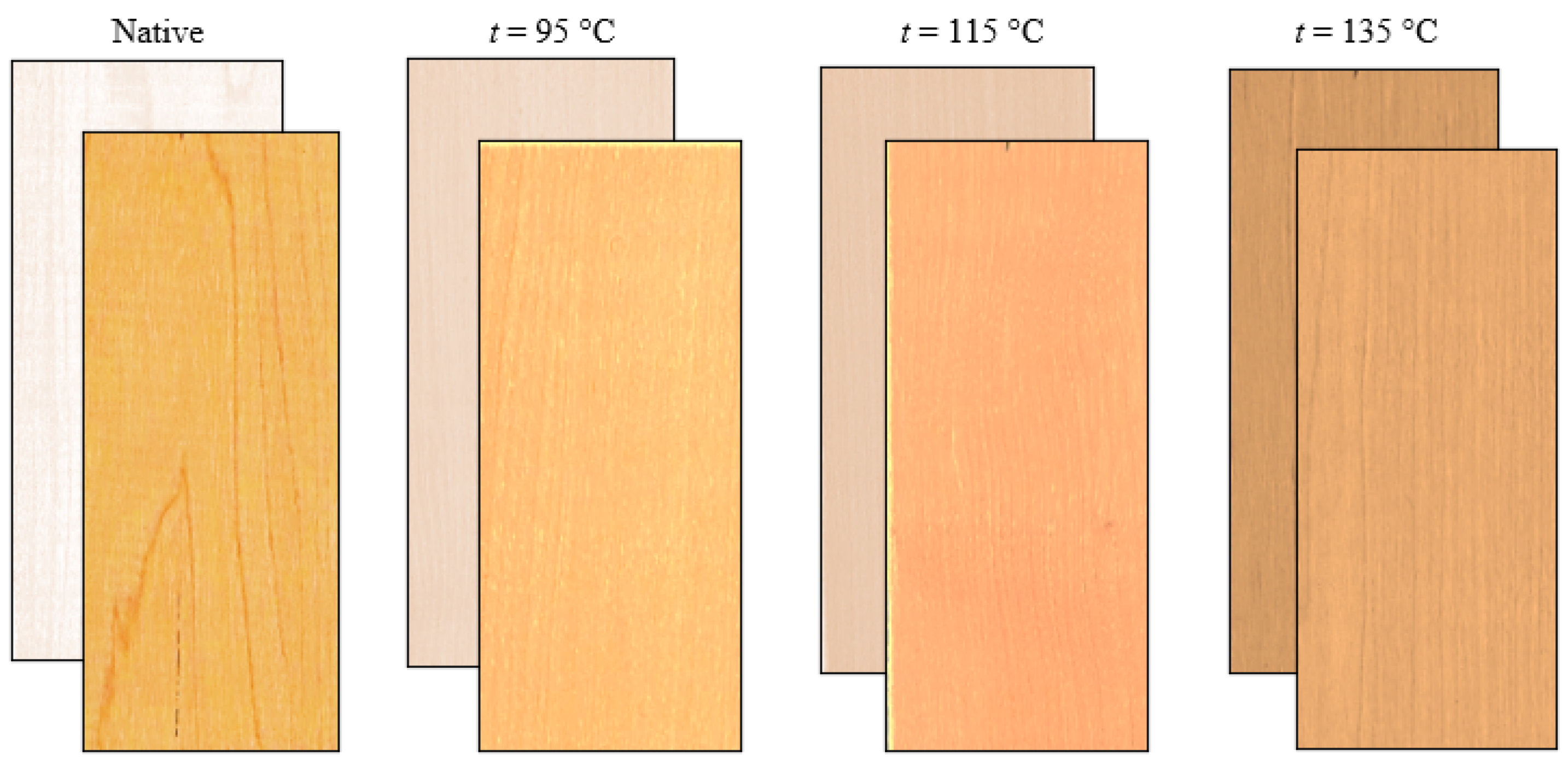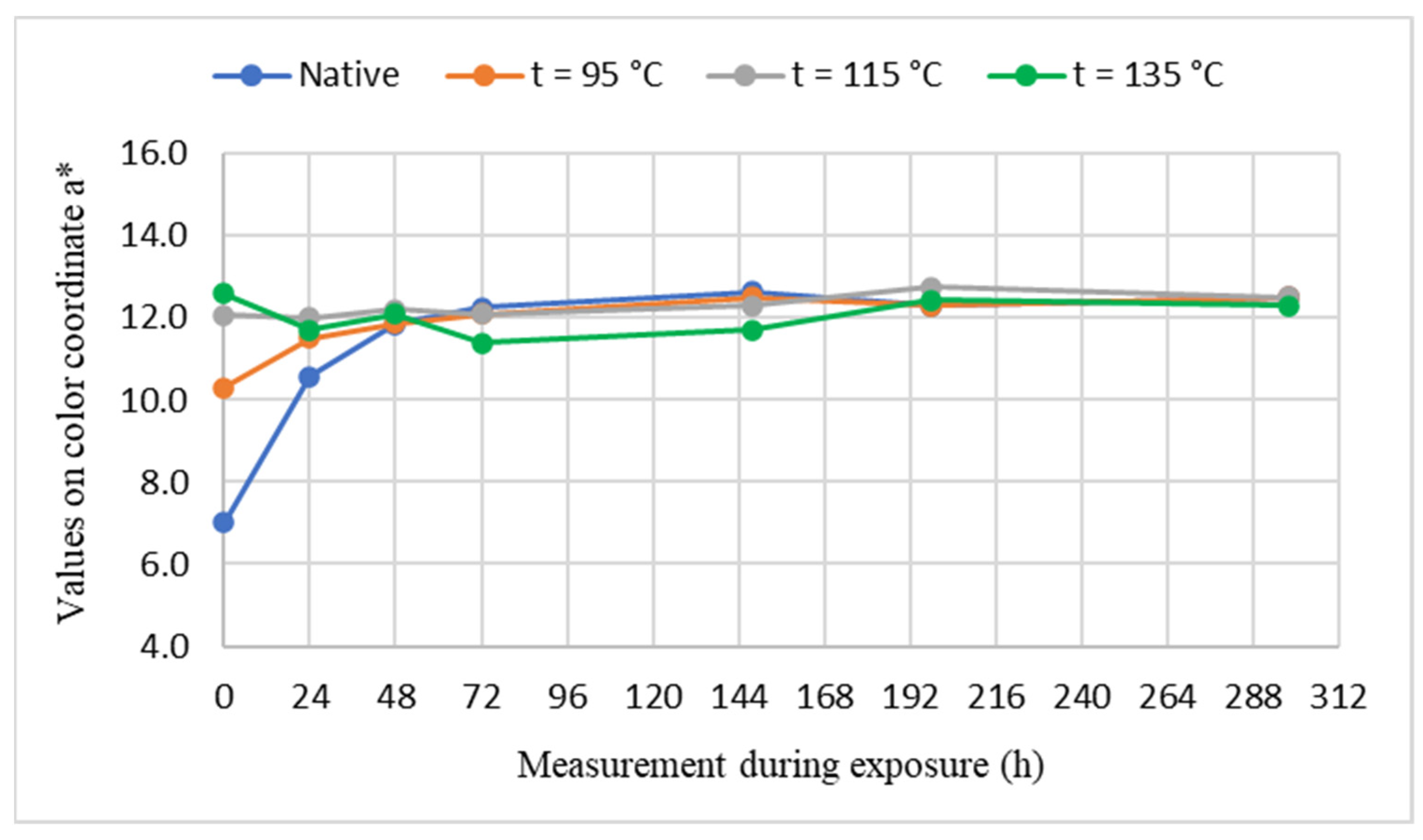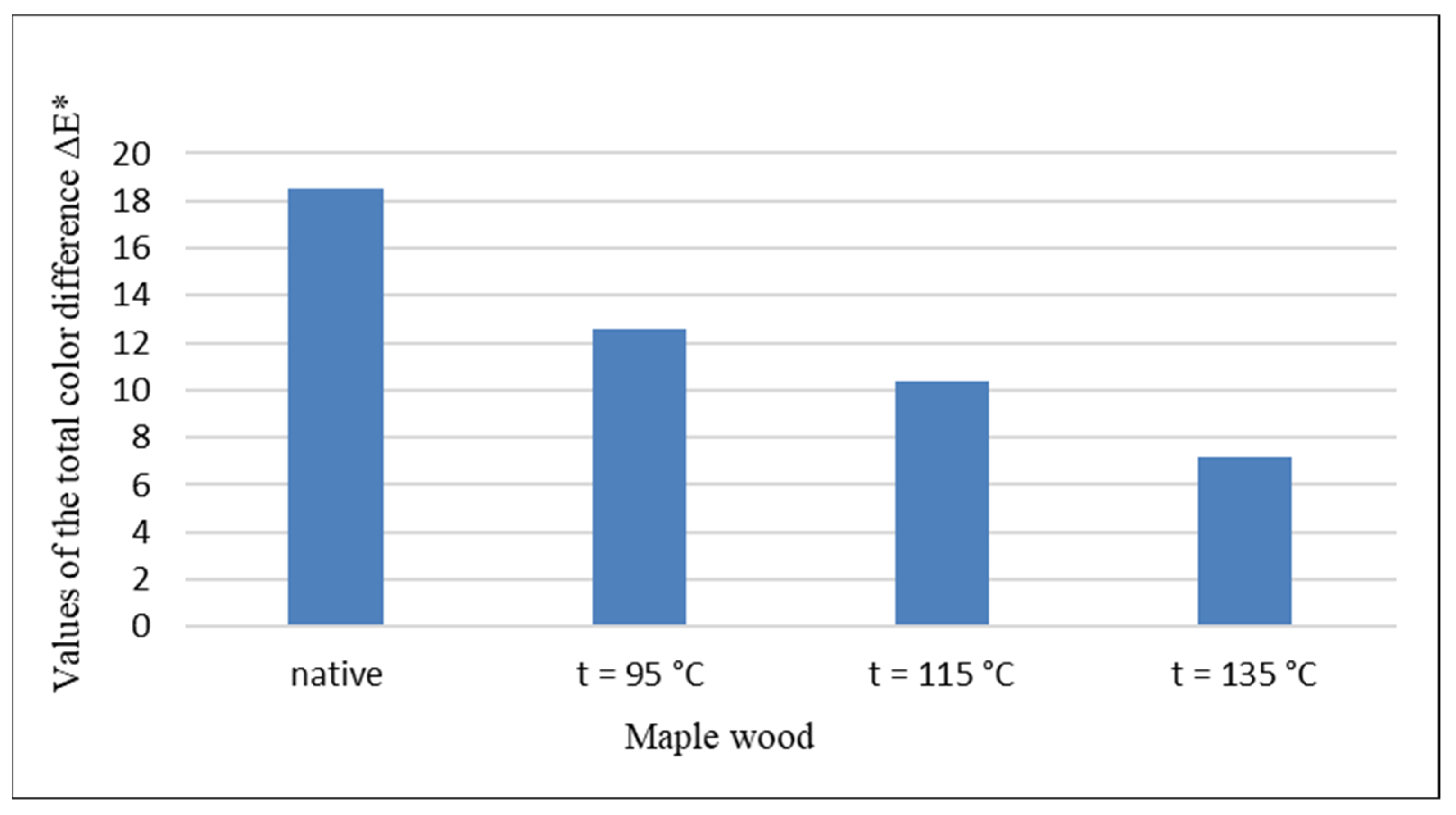Influence of UV Radiation on the Color Change of the Surface of Steamed Maple Wood with Saturated Water Steam
Abstract
:1. Introduction
2. Material and Methods
2.1. Material
2.2. Color Measurement of Maple Wood
2.3. Irradiation of Maple Wood in Xenon Test Chamber
2.4. Analysis of Changes in Lignin-Cellulose Matrix of Wood ATR-FTIR Spectroscopy
3. Results and Discussion
3.1. Color Analysis
3.2. ATR-FTIR Spectroscopy Analysis
4. Conclusions
Author Contributions
Funding
Institutional Review Board Statement
Informed Consent Statement
Data Availability Statement
Conflicts of Interest
References
- Barański, J.; Klement, I.; Vilkovská, T.; Konopka, A. High temperature drying process of beech wood (Fagus sylvatica L.) with different zones of sapwood and red false heartwood. BioResources 2017, 12, 1861–1870. [Google Scholar] [CrossRef] [Green Version]
- Barcik, Š.; Gašparík, M.; Razumov, E.Y. Effect of thermal modification on the colour changes of oak wood. Wood Res. 2015, 60, 385–396. [Google Scholar]
- Bekhta, P.; Niemz, P. Effect of high temperature on the change in colour, dimensional stability and mechanical properties of spruce wood. Holzforschung 2003, 57, 539–546. [Google Scholar] [CrossRef]
- Cividini, R.; Travan, L.; Allegretti, O. White beech: A tricky problem in drying process. In Proceedings of the International Scientific Conference on Hardwood Processing, Quebec City, QC, Canada, 24–26 September 2007. [Google Scholar]
- Deliiski, N. Metod dlja ocenki stepeni oblagoraživania bukovych pilomaterialov vo vremja ich proparki. In Current Problems and Perspectives of Beech Lumber Drying; ES-VŠLD: Zvolen, Slovakia, 1991; pp. 37–44. [Google Scholar]
- Dudiak, M.; Dzurenda, L. Changes in the physical and chemical properties of alder wood in the process of thermal treatment with saturated water steam. Coatings 2021, 11, 898. [Google Scholar] [CrossRef]
- Dzurenda, L. Colouring of Beech Wood during Thermal Treatment using Saturated Water Steams. Acta Fac. Xylologiae Zvolen 2014, 56, 13–22. [Google Scholar]
- Gonzalez-Pena, M.M.; Hale, M.D.C. Colour in thermally modified wood of beech, Norway spruce and Scots pine. Part 1: Colour evolution and colour changes. Holzforschung 2009, 63, 385–393. [Google Scholar] [CrossRef]
- Milić, G.; Todorović, N.; Popadić, R. Influence of steaming on drying quality and colour of beech timber. Glasnik Šumarskog Fakulteta 2015, 83–96. [Google Scholar] [CrossRef]
- Molnar, S.; Tolvaj, L. Colour homogenisation of different wood species by steaming. In Interaction of Wood with Various Forms of Energy; Technical University in Zvolen: Zvolen, Slovakia, 2002; pp. 119–122. [Google Scholar]
- Todaro, L.; Zuccaro, L.; Marra, M.; Basso, B.; Scopa, A. Steaming effects on selected wood properties of Turkey oak by spectral analysis. Wood Sci. Technol. 2012, 46, 89–100. [Google Scholar] [CrossRef]
- Tolvaj, L.; Nemeth, R.; Varga, D.; Molnar, S. Colour homogenisation of beech wood by steam treatment. Drewno 2009, 52, 5–17. [Google Scholar]
- Geffert, A.; Vybohová, E.; Geffertová, J. Characterization of the changes of colour and some wood components on the surface of steamed beech wood. Acta Fac. Xylologiae Zvolen 2017, 59, 49–57. [Google Scholar]
- Dzurenda, L.; Dudiak, M. Cross-correlation of color and acidity of wet beech wood in the process of thermal treatment with saturated steam. Wood Res. 2021, 66, 105–116. [Google Scholar] [CrossRef]
- Banski, A.; Dudiak, M. Dependence of color on the time and temperature of saturated water steam in the process of thermal modification of beech wood. AIP Conferen. Proc. 2019, 2118, 30003. [Google Scholar]
- Tolvaj, L.; Molnár, S. Colour homogenisation of hardwood species by steaming. Acta Silv. Lignaria Hung. 2006, 2, 105–112. [Google Scholar]
- Dzurenda, L. The shades of color of Quercus robur L. wood obtained through the processes of thermal treatment with saturated water vapour. BioResources 2018, 13, 1525–1533. [Google Scholar] [CrossRef] [Green Version]
- Dzurenda, L. Colour modification of Robinia pseudoacacia L. during the processes of heat treatment with saturated water steam. Acta Fac. Xylologiae Zvolen 2018, 60, 61–70. [Google Scholar]
- Dudiak, M. Modification of maple wood colour during the process of thermal treatment with saturated water steam. Acta Fac. Xylologiae Zvolen 2021, 63, 25–34. [Google Scholar]
- Hon, D.S.N. Weathering and photochemistry in wood. In Wood and Cellulosic Chemistry, 2nd ed.; Hon, D.S.N., Shiraishi, N., Eds.; MarcelDekker: New York, NY, USA, 2001; pp. 513–546. [Google Scholar]
- Reinprecht, L. Wood Protection; Technical University in Zvolen: Zvolen, Slovakia, 2008; p. 450. [Google Scholar]
- Baar, J.; Gryc, V. The analysis of tropical wood discoloration caused by simulated sunlight. Eur. J. Wood Wood Prod. 2011, 70, 263–269. [Google Scholar] [CrossRef]
- Gandelová, L.; Horáček, P.; Šlezingerová, J. The Science of Wood; Mendel University of Agriculture and Forestry in Brno: Brno, Czech Republic, 2009; p. 176. [Google Scholar]
- Müller, U.; Rätzsch, M.; Schwanninger, M.; Steiner, M.; Zöbl, H. Yellowing and IR-changes of spruce wood as result of UV-irradiation. J. Photochem. Photobiol. B Biol. 2003, 69, 97–105. [Google Scholar] [CrossRef]
- Pandey, K.K. Study of the effect of photo-irradiation on the surface chemistry of wood. Polym. Degrad. Stab. 2005, 90, 9–20. [Google Scholar] [CrossRef]
- Persze, L.; Tolvaj, L. Photodegradation of wood at elevated temperature: Colour change. J. Photochem. Photobiol. B Biol. 2012, 108, 44–47. [Google Scholar] [CrossRef]
- Denes, L.; Lang, E.M. Photodegradation of heat-treated hardwood veneers. J. Photochem. Photobiol. B Biol. 2013, 118, 9–15. [Google Scholar] [CrossRef] [PubMed]
- Zivkovic, V.; Arnold, M.; Radmanovic, K.; Richter, K.; Turkulin, H. Spectral sensitivity in the photodegradation of fir wood (Abies alba Mill.) surfaces: Colour changes in natural weathering. Wood Sci. Technol. 2014, 48, 239–252. [Google Scholar] [CrossRef] [Green Version]
- Geffertová, J.; Geffert, A.; Vybohová, E. The effect of UV irradiation on the colour change of the spruce wood. Acta Fac. Xylologiae Zvolen 2018, 60, 41–50. [Google Scholar]
- Chang, T.C.; Chang, H.T.; Chang, S.T. Influences of extractives on the photodegradation of wood. Polym. Degrad. Stab. 2010, 95, 516–521. [Google Scholar] [CrossRef]
- Kúdela, J.; Kubovský, I. Accelerated-ageing-induced photo-degradation of beech wood surface treated with selected coating materials. Acta Fac. Xylologiae Zvolen 2016, 2, 27–36. [Google Scholar]
- Dzurenda, L. The effect of UV radiation in Xenotest 450 on the colour of steamed beech wood during the process of simulated ageing. Ann. Wars. Univ. Life Sci. For. Wood Technol. 2019, 106, 114–119. [Google Scholar] [CrossRef]
- Varga, D.; Tolvaj, L.; Molnar, Z.; Pasztory, Z. Leaching efect of water on photodegraded hardwood species monitored by IR spectroscopy. Wood Sci. Technol. 2020, 54, 1407–1421. [Google Scholar] [CrossRef]
- Cogulet, A.; Blanchet, P.; Landry, V. Wood degradation under UV irradiation: A lignin characterization. J. Photochem. Photobiol. B Biol. 2016, 158, 184–191. [Google Scholar] [CrossRef]
- Zborowska, M.; Stachowiak-Wencek, A.; Waliszewska, B.; Prądzyński, W. Colorimetric and FTIR ATR spectroscopy studies of degradative effects of ultraviolet light on the surface of exotic ipe (Tabebuia sp.) wood. Cellulose Chem. Technol. 2016, 50, 71–76. [Google Scholar]
- Teaca, C.-A.; Rosu, D.; Bodirlau, R.; Rosu, L. Structural changes in wood under arteficial UV light irradiation determined by FTIR spectroscopy and color measurement—A brief review. BioResources 2014, 8, 1478–1507. [Google Scholar]
- Colom, X.; Carrillo, F.; Nogués, F.; Garriga, P. Structural analysis of photodegraded wood by means of FTIR spectroscopy. Polym. Degrad. Stab. 2003, 80, 543–549. [Google Scholar] [CrossRef]






| Maple Wood | Wood Color | Color Coordinates in the Color Space CIE L*a*b* | ||
|---|---|---|---|---|
| L* | a* | b* | ||
| unsteamed maple wood | pale white-yellow | 84.2 ± 2.4 | 7.1 ± 1.5 | 15.6 ± 1.9 |
| steamed at t = 95 ± 2.5 °C | pale pink-brown | 75.0 ± 1.8 | 10.3 ± 1.4 | 16.0 ± 1.6 |
| steamed at t = 115 ± 2.5 °C | light brown | 69.7 ± 1.6 | 11.9 ± 1.4 | 16.4 ± 1.4 |
| steamed at t = 135 ± 2.5 °C | brown-red | 61.1 ± 1.4 | 12.6 ± 1.3 | 16.9 ± 1.6 |
| Maple Wood | Color Coordinates of Samples in the CIE L*a*b* Sample Area before and after UV Irradiation in the Q-SUN Xe-3-H Test Chamber | ||||||||
|---|---|---|---|---|---|---|---|---|---|
| L0* | L298* | ∆L* | a0* | a298* | ∆a* | b0* | b289* | ∆b* | |
| unsteamed maple wood | 84.2 | 71.9 | −12.3 | 7.0 | 12.5 | +5.8 | 15.6 | 28.3 | +12.7 |
| steamed at t = 95 ± 2.5 °C | 75.0 | 69.8 | −5.2 | 10.3 | 12.5 | +2.1 | 16.0 | 27.5 | +11.5 |
| steamed at t = 115 ± 2.5 °C | 69.7 | 69.3 | −0.4 | 11.9 | 12.5 | +0.6 | 16.4 | 26.8 | +10.4 |
| steamed at t = 135 ± 2.5 °C | 61.1 | 63.9 | +2.8 | 12.6 | 12.3 | −0.3 | 16.9 | 23.5 | +6.6 |
| Maple Wood Samples | Ad (1720) (%) | Ad (1504) (%) | Ad (1235) (%) |
|---|---|---|---|
| unsteamed maple wood | 157.23 | −96.02 | −25.30 |
| steamed at t = 95 ± 2.5 °C | 116.80 | −96.24 | −31.56 |
| steamed at t = 115 ± 2.5 °C | 121.43 | −97.37 | −35.04 |
| steamed at t = 135 ± 2.5 °C | 118.23 | −100.00 | −31.69 |
Publisher’s Note: MDPI stays neutral with regard to jurisdictional claims in published maps and institutional affiliations. |
© 2022 by the authors. Licensee MDPI, Basel, Switzerland. This article is an open access article distributed under the terms and conditions of the Creative Commons Attribution (CC BY) license (https://creativecommons.org/licenses/by/4.0/).
Share and Cite
Dzurenda, L.; Dudiak, M.; Výbohová, E. Influence of UV Radiation on the Color Change of the Surface of Steamed Maple Wood with Saturated Water Steam. Polymers 2022, 14, 217. https://doi.org/10.3390/polym14010217
Dzurenda L, Dudiak M, Výbohová E. Influence of UV Radiation on the Color Change of the Surface of Steamed Maple Wood with Saturated Water Steam. Polymers. 2022; 14(1):217. https://doi.org/10.3390/polym14010217
Chicago/Turabian StyleDzurenda, Ladislav, Michal Dudiak, and Eva Výbohová. 2022. "Influence of UV Radiation on the Color Change of the Surface of Steamed Maple Wood with Saturated Water Steam" Polymers 14, no. 1: 217. https://doi.org/10.3390/polym14010217
APA StyleDzurenda, L., Dudiak, M., & Výbohová, E. (2022). Influence of UV Radiation on the Color Change of the Surface of Steamed Maple Wood with Saturated Water Steam. Polymers, 14(1), 217. https://doi.org/10.3390/polym14010217







